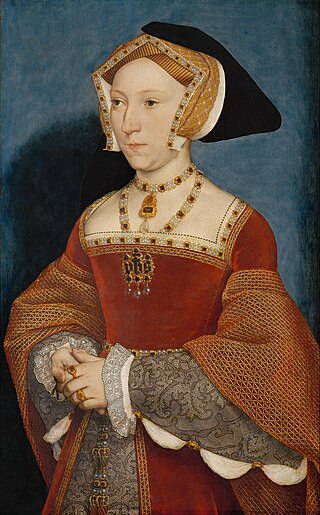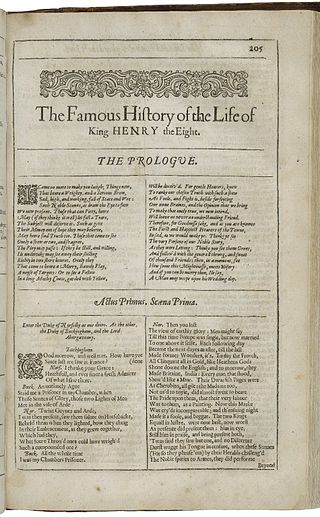This article relies largely or entirely on a single source .(October 2021) |
A Treaty of Perpetual Peace was signed in 1534 between James V of Scotland and Henry VIII of England. [1]
This article relies largely or entirely on a single source .(October 2021) |
A Treaty of Perpetual Peace was signed in 1534 between James V of Scotland and Henry VIII of England. [1]

Catherine of Aragon was Queen of England as the first wife of King Henry VIII from their marriage on 11 June 1509 until its annulment on 23 May 1533. Born in Spain, she was Princess of Wales while married to Henry's elder brother, Arthur, Prince of Wales, for a short period before his death.

Henry VIII was King of England from 22 April 1509 until his death in 1547. Henry is known for his six marriages and his efforts to have his first marriage annulled. His disagreement with Pope Clement VII about such an annulment led Henry to initiate the English Reformation, separating the Church of England from papal authority. He appointed himself Supreme Head of the Church of England and dissolved convents and monasteries, for which he was excommunicated by the pope.

Thomas Wolsey was an English statesman and Catholic cardinal. When Henry VIII became King of England in 1509, Wolsey became the king's almoner. Wolsey's affairs prospered and by 1514 he had become the controlling figure in virtually all matters of state. He also held important ecclesiastical appointments. These included the Archbishop of York—the second most important role in the English church—and that of papal legate. His appointment as a cardinal by Pope Leo X in 1515 gave him precedence over all other English clergy.

Anne Boleyn was Queen of England from 1533 to 1536, as the second wife of King Henry VIII. The circumstances of her marriage and execution by beheading for treason, made her a key figure in the political and religious upheaval that marked the start of the English Reformation.

Jane Seymour was Queen of England as the third wife of King Henry VIII from their marriage on 30 May 1536 until her death the next year. She became queen following the execution of Henry's second wife, Anne Boleyn, who was accused by King Henry VIII of adultery after failing to produce the male heir he so desperately desired. Jane, however, died of postnatal complications less than two weeks after the birth of her only child, the future King Edward VI. She was the only wife of Henry to receive a queen's funeral; and he was later buried alongside her remains in St George's Chapel, Windsor Castle.

Anne of Cleves was Queen of England from 6 January to 12 July 1540 as the fourth wife of King Henry VIII. Not much is known about Anne before 1527, when she became betrothed to Francis, Duke of Bar, son and heir of Antoine, Duke of Lorraine, although their marriage did not proceed. In March 1539, negotiations for Anne's marriage to Henry began, as Henry believed that he needed to form a political alliance with her brother, William, who was a leader of the Protestants of Western Germany, to strengthen his position against potential attacks from Catholic France and the Holy Roman Empire.

Henry VIII is a collaborative history play, written by William Shakespeare and John Fletcher, based on the life of Henry VIII. An alternative title, All Is True, is recorded in contemporary documents, with the title Henry VIII not appearing until the play's publication in the First Folio of 1623. Stylistic evidence indicates that individual scenes were written by either Shakespeare or his collaborator and successor, John Fletcher. It is also somewhat characteristic of the late romances in its structure. It is noted for having more stage directions than any of Shakespeare's other plays.

In common parlance, the wives of Henry VIII were the six queens consort of King Henry VIII of England between 1509 and his death in 1547. In legal terms, Henry had only three wives, because three of his marriages were annulled by the Church of England. However, he was never granted an annulment by the Pope, as he desired, for Catherine of Aragon, his first wife. Annulments declare that a true marriage never took place, unlike a divorce, in which a married couple end their union. Along with his six wives, Henry took several mistresses.
Events from the year 1525 in Ireland.
Events from the year 1546 in Ireland.
Events from the year 1532 in Ireland.
Events from the year 1514 in Ireland.
Events from the year 1521 in Ireland.
Events from the year 1517 in Ireland.
Events from the year 1524 in Ireland.
Events from the year 1520 in Ireland.
Events from the year 1519 in Ireland.
Events from the year 1528 in Ireland.
Events from the year 1512 in Ireland.